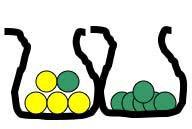Put out
After transferring balls back and forth between two bags the probability of selecting a green ball from bag 2 is 3/5. How many green balls were in bag 2 at the outset?
Problem
Image

| There are 5 yellow balls in bag 1. One ball is transferred to bag 2 which contains an unknown number of green balls.
Bag 2 is then shaken and a ball is selected at random and transferred to bag 1 without seeing its colour.
Bag 1 is then shaken and a ball is selected at random and transferred to bag 2 without seeing its colour.
Finally, a ball is chosen at random from bag 2. |
If I tell you before you carry out this process that there's a $\frac{3}{5}$ chance you will end up with a green ball at the end, can you work out how many green balls are in bag 2 at the start?
Getting Started
Record what happens in a tree diagram.
Student Solutions
Stage 1. There are 5 yellow balls in bag 1. One ball is transferred to bag 2 which contains an unknown number of green balls.
Stage 2. Bag 2 is then shaken and a ball is selected at random and transferred to bag 1 without seeing its colour.
Stage 3 . Bag 1 is then shaken and a ball is selected at random and transferred to bag 2 without seeing its colour.
Stage 4. Given all this has happened, the probability of selecting a green ball from bag 2 is now 3/5, so how many green balls were there in bag 2 at the outset?
Gordon of Madras College correctly used a tree diagram and the conditional probability of a green ball being chosen given all possible sequences of events leading up to the last draw.
Let ( y 1 , g 1 ) and ( y 2 , g 2 ) denote the numbers of yellow and green balls in the two bags,
e.g. (5, 0) (0, n ) at the outset for bags 1 and 2 respectively.
| Stage 1 A yellow ball is transferred from bag 1 to bag 2. | Stage 2 One ball is transferred from bag 2 to bag 1. | Stage 3 One ball is transferred from bag 1 to bag 2 | There are 3 possible outcomes | Probabilities of each outcome | Stage 4 A ball is drawn from bag 2. Probability that this ball is green. | |||
(5,0) (0, n) | Image
| (4,0) (1, n ) | Image
| (5, 0) (0,n ) | Image
| (4,0) (1, n ) | 1/( n +1) | [1/ ( n +1)]* [ n / ( n +1)] |
Image
| (4, 1) (1, n -1) | Image
pr( y )=4/5 | (3,1) (2, n -1) | 4 n /5( n +1) | [4 n / 5( n +1)]* [( n -1)/( n +1)] | |||
| pr(g) =1/5 | (4,0) (1, n ) | n /5( n +1) | [ n /5( n +1)]* [ n / ( n +1)] | |||||
Denote the transfers at stage 2 and 3 by (yellow, yellow), (yellow, green), (green, yellow), (green, green) and note that (yellow, green) is impossible so it has zero probability. At stage 4 a ball is picked at random from bag 2. The probability that this ball (say ball x) is green is given by the sum of the probabilities in the right hand column of the tree diagram above.
| pr ( x = green) = | |
| + pr ( x = green | (yellow, green)) | |
| + pr ( x = green | (green, yellow)) | |
| + pr ( x = green | (green, green)) |
As we are told pr( x = green) = 3/5
[1 / ( n +1)][ n / ( n +1)] + 0 + [4 n / 5( n +1)][( n - 1) / ( n +1)] + [ n /5( n +1)][ n / ( n +1)] = 3/5.
Multiplying by 5( n +1) 2
5 n + 4 n ( n - 1) + n 2 = 3( n + 1) 2
2 n 2 - 5 n - 3 = 0
( n - 3)(2 n + 1) = 0.
So there were 3 green balls in bag 2 at the start (discounting the impossible solution n = - $\frac {1}{2}$).
Teachers' Resources
Why do this problem?
This problem is set in a simple context which lends itself to the use of a tree diagram, but it needs careful and clear thinking as well as fluent algebra to reach a solution.
Key questions
What is unknown?
How can we record the information?
Can we form an equation from the information given?
Possible support
Try How Many Balls? and Fixing The Odds
